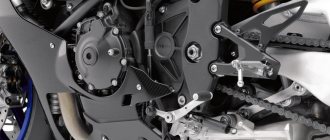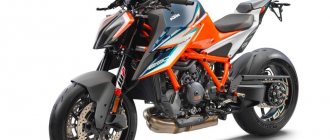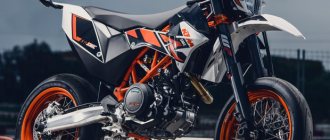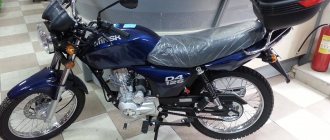KTM-250 EXC: test drive
The tests carried out on the “enduro” in question made it possible to identify its strengths and weaknesses. First, it should be noted that it is necessary to regularly monitor the oil level in gasoline, otherwise you will have to rebuild half the engine. Among other features, the following points are noted:
- Particular attention must be paid to the serviceability of the engine stop key and the throttle cable. The last element has a single structure, which risks biting it in the maximum position. In this case, only a working button will allow you to get out of the situation. Setting up the power unit in terms of jets and needles is available in the manual.
- One of the weak points of the engine is the resonator pipe. It serves to ensure the nature of traction. If it deforms on road elements, traction disappears at low speeds.
- The brakes of the KTM-250 motorcycles are beyond praise. They ensure reliable stopping of the machine. One of the unpleasant moments may be that air gets trapped in the system when the bike turns over, however, this happens extremely rarely.
- With adequate control, the discs and basket are practical and durable, despite the fact that you often have to use the clutch.
Repetition of covered material
Compared to the previous year, the motorcycle... has practically not changed - except for a few small and mostly cosmetic improvements, which, of course, do not detract from its undoubted advantages. The new 250 EXC-F, like the rest of the KTM enduro family, features the bright orange frame that was once the hallmark of the specially prepared Six Days race modification.
The frame itself, apart from its elegant appearance, has not received any changes: it is still the same rigid and lightweight skeleton made of chrome-molybdenum steel with thin-walled lower pipes, the use of which has reduced the weight of the structure by 300 g. The aluminum alloy pendulum has minimal weight and optimal rigidity . The front fully adjustable WP fork with stays with a diameter of 48 mm and wheel travel of 300 mm was developed specifically for sports enduro and differs from its motocross counterparts in other settings.
The 330mm travel rear monoshock is also from WP. The motorcycle is equipped with a 249.9 cc 1-cylinder 4-stroke petrol engine with a liquid cooling system. In 2013, Austrian engineers radically redesigned the cylinder head, increasing the area of the intake valves and installing new camshafts, and a new forged piston appeared in the CPG.
This made it possible to increase the power and torque of the power plant. The power system is Keihin fuel injection with electronic control. The DDS clutch with a central damper spring and a new basket made it possible to significantly reduce the size of this unit and dramatically increase its reliability.
Despite its modest cylinder displacement, the 250 EXC-F engine can easily compete with any of its peers! Kickstarter can only be purchased as additional equipment.
I also note that due to the use of a Brembo hydraulic drive, the force on the clutch lever is minimal. I’m glad that the KTM engineering department worked some magic with the previously very unreliable electric starter and brought the number of its failures to a minimum. The engine is equipped with a 6-speed gearbox, which in 2015 had changed gear ratios to increase the maximum speed of the motorcycle.
The KTM 250 EXC-F is equipped with benchmark Brembo brakes, which were updated in 2014 and are more efficient than their predecessors. Since 2015, the motorcycle has been equipped with a Neken steering wheel and black Excel aluminum wheels. There is also a new MAE speedometer, rear driven sprocket, more ergonomic, streamlined hand guards, rubber handlebar grips and new graphics on the protective plastic.
Brembo brakes are standard on KTM off-road motorcycles. The aluminum swingarm is designed to reduce the unsprung mass of the rear suspension.
KTM 250 SX On the track
All testers noted that the KTM 250 SX is extremely aggressive and is a stark contrast to the YZ250, which maintains a steady but sedate pace early in the rev range. It is worth noting that the 250 SX versions of 2021 - 2021 are a little quieter than in 17-18, but this is mainly a consequence of a number of changes in the airbox design, which led to a slight decrease in its cross-country ability.
Switching to a two-stroke from a four-stroke, on the first lap you will feel that the 2021 KTM 250 SX is an extremely fun machine. Racing a two-stroke is a special art of high-speed meditation, during which you need to be sharp and calm at the same time. At first, the KTM 250 SX will try to lift the front wheel with every sneeze, tear the rear wheel off at the mere thought on flat turns and crawl much more than any four-stroke.
Don't worry. After a few laps, or days, or months, you'll find your seat, learn more about throttle control, and realize that its restlessness and sharpness are exactly what allow the 250cc two-stroke to be a completely versatile off-road bike that can go literally anywhere, and then also get out of there, be it a jump or a climb. Breathe evenly, relax and let the 250 SX do its job. It will give you a feeling that you can't get from a big, heavy, slow-turning, tight-to-ground four-stroke.
Traction
There's no need to get used to the stock traction on the KTM 250 SX. Its character can be changed to suit your needs with a couple of simple modifications. Here are five:
- Holes. For those who need everything at once, who need a sharp response and powerful impulses from the bottom, they will have to improve the engine purging. How? Drilling holes in the airbox cover. Don't be alarmed, there is nothing scary in this procedure. And the more holes are drilled, the easier it will be for the engine to breathe; the main thing is not to drill holes near the filter, so as not to allow air into the engine bypassing it. The extra air will perk up the engine significantly—perhaps even more than you'd like. And yes, you will probably have to richen the mixture with a needle and tighten the air screw.
- Gear ratio. You might find the KTM 250 SX's torque plateau too narrow, especially compared to the YZ250. Change the rear sprocket! With just one less tooth, the traction will be smoother, the gears will be more varied, and the high-torque rev range will expand, allowing you to shift less frequently.
- Power valve. There is a bronze screw on the right side of the KTM engine, right under the pump. This screw allows you to adjust the power valve spring preload. Turning counterclockwise makes the KTM 250 SX's engine live faster—even to the point of jerky and unpredictable thrust if cranked too far. By turning the adjuster clockwise, you make the engine softer and smoother. Our ideal option is to unscrew the screw all the way and turn it 1 turn clockwise. This slightly slows down the engine's acceleration, expands the torque plateau and smoothes out twitchy traction at medium speeds.
- External power valve springs. The bronze screw adjusts the main spring preload, which affects when the power valve begins to open, but that's not all. The valve design has a spring, the stiffness of which affects the speed of its opening and the speed at which it will be fully open - and this spring is also replaceable. KTM offers three spring options, green, yellow and red. Replacing this spring makes the valve open faster (red spring) or slower (green spring). The yellow spring is installed in the drain.
- Ignition cards. The 2021 KTM 250 SX comes with two integrated ignition maps. But this model, unlike its Husqvarna-branded twin, doesn't have a stock map switch, and it's not entirely obvious how to switch between them. On the KTM 250 SX this is done as follows: a more aggressive map works in stock, and you can switch to a softer one by undocking the connector located under the tank on the left. It's a single white plastic connector and is easy to identify. A soft map makes the engine smoother and its thrust more manageable. This is especially useful on rocky and slippery surfaces. And yes, the result is worth the effort spent fiddling with the wire, although the stock aggressive map is quite suitable for a trained rider.
Fork and its settings
The advantage of the KTM 250 SX 2021 air fork is that its operation is highly adjustable to suit different conditions on the track, different weights of the rider and his skills. As a rule, even with rough tuning, the fork behaves well, except in situations where it breaks. But for optimal suspension performance, you need to find the right pressure, and here's how to do it.
Place a regular plastic zip tie on the right fork leg and pump in the stock 148 psi (10.2 bar). Go for a couple of laps at your full speed. Then look at the position of the tie on the feather. If it did not slide down by the end of the stroke (i.e. it was far from the breakdown), release 2 psi, move the tie back and ride again. Continue until the coupler is at a distance of 1.5-2 cm from the end of the stroke (from the breakdown) - this will mean that you personally know your pressure in the fork. Why leave an extra 2 cm of travel? Yes, because at some point you will jump a little higher, or vice versa too close, or unexpectedly discover a talent in yourself that you didn’t know about, and it will require a margin of safety from the fork. This margin of safety lies in those 2 cm of travel.
Cons of the 2020 KTM 250 SX
- Airbox. It takes power. Yes, it's an easy fix, but a stock bike is always better than one modified with a drill.
- Frame. Fast riders will appreciate the 2019-20 version's rigid frame because it's more responsive to rider input. Slow riders won't appreciate it because it conveys trail bumps too well.
- Engine. Undoubtedly powerful, but in its basic form it works best in the midrange, and almost nothing at the top. If it were smoother and pulled longer, it would be better.
Pros of the 2020 KTM 250 SX
- Brakes. Excellent, informative, powerful and fun to work with.
- Clutch. Hydraulic, self-adjusting with a disc spring and rubber dampers that smooth out an insufficiently steady hand on the lever.
- Filter. More precisely, the ease of its replacement: in a world where filters are hidden in the darkest places, KTM’s arrangement is just a ray of light.
- Hour meter. Its very presence in the stock is great, but the second plus is that it is located on the upper traverse, so it is clearly visible.
- Fork. The 48 WP fork works great and is very adjustable. Yes, it requires some understanding of tuning and pressure selection, but nothing like the nightmare tuning procedures of the KYB PSF or Showa SFF-TAC.
- Power valve regulator. It’s very cool that it’s adjustable, however, there is a downside: it requires a Robertson square screwdriver. Fortunately, the regulator itself is easy to replace with a Kreft Powerdial - it can be turned simply by hand. Therefore, this item is not on the list of shortcomings.
- Controllability. You don't know much about cross-country unless you've ridden a 200-pound two-stroke with instant throttle response and the ability to easily change line through a corner. And when you figure out how to adjust the suspensions - pressure and sag - you will generally see the light.











